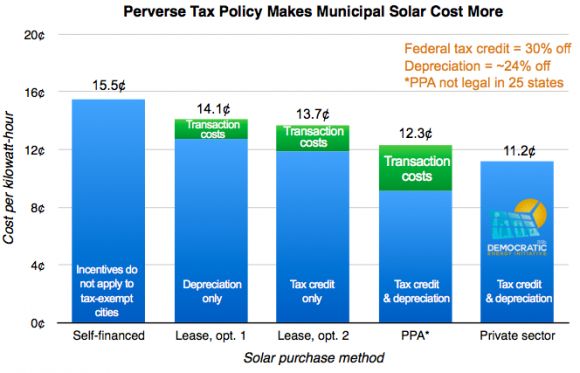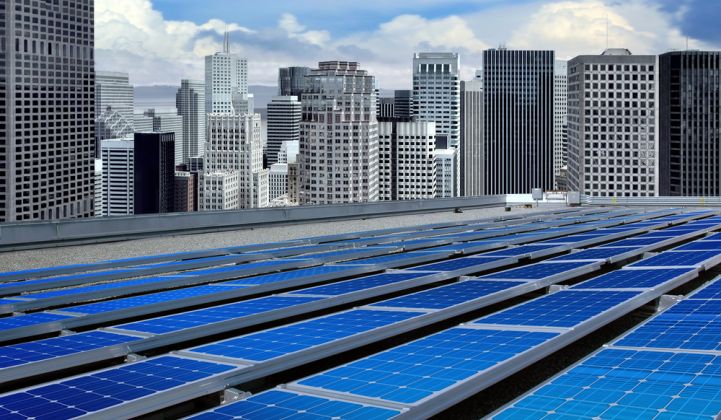Municipal buildings represent an enormous untapped opportunity for solar that could significantly lower operating costs and free up millions of taxpayer dollars, according to a new report from the Institute for Local Self-Reliance (ILSR).
ILSR estimates that more than 5,000 megawatts of solar could be affordably installed on municipal property across all the cities in the U.S. with a population greater than 100,000. That figure represents roughly a quarter of all solar installed in the United States to date.
Not only will going solar save cities money, but it will also shrink their carbon footprint, create jobs and have several other positive spillover effects, said John Farrell, director of ILSR’s democratic energy initiative and author of the report.
“It is giving [municipalities] more control over their entire energy system, and that informs their regulation of private entities doing solar,” said Farrell. “Cities that put solar on their rooftops may decide to lower permitting fees for private solar, or take other actions to support the industry.”
“It also means that dollars spent on energy that previously went to a private electric company and might have gone out of the region or state, now those dollars remain local and could go to something else in the city budget, to some public use,” he added.
But in order to access the benefits of going solar, most local officials will first need to overcome a handful of policy and bureaucratic barriers.

Since municipalities are not allowed to take advantage of federal tax credits, the report finds a city’s best option is to buy solar power from a third-party installer (via a power-purchase agreement, or PPA). Third parties can claim the 30 percent tax incentive for solar projects on behalf of the city, plus a tax write-off for deprecation of the project’s value, and pass along savings to the customer.
Third parties also help cover upfront costs and manage project maintenance. Taken together, this makes going solar a simple transaction for cities that may not have the technical know-how to set up a project on their own.
However, third-party agreements are only legal in about half of the U.S. In states where third-party agreements are prohibited, municipal leaders have the option to purchase a solar system directly, but that means they can’t take advantage of federal incentives. According to the report, the lifetime value of a solar project with a PPA or a third-party lease is substantially higher than a project that is self-financed.
Several legislatures and public utility commissions in the U.S. are grappling with the idea of allowing third-party solar ownership. Georgia recently passed a bill allowing customers to lease rooftop solar arrays and sell excess energy back to the grid. Other states could follow suit.

There are other barriers besides limited access to third-party agreements that will have to be overcome. In some cities, public buildings may be prevented from owning solar because they have historical significance, or because officials feel it will look unattractive. Public buildings may also have obstructed roofs or roofs that are simply too weak to host solar.
Many city officials are also hesitant to adopt solar, even where third-party financing is available, because they’re worried about getting a bad deal. Many cities don't have experience negotiating energy purchases. Meanwhile, from a solar company’s perspective, working with a bureaucratic government can be too onerous to be worthwhile.
Furthermore, while net metering is considered by many to be a key policy driver for rooftop solar, several cities have size or output limitations on net-metered solar installations. Aggregate net metering and virtual net metering can help to maximize a city’s solar benefits, but these policies exist in just 17 and 11 states, respectively.
How five cities overcame the barriers to solar adoption
Despite these challenges, ILSR found a number of cities have been able to adopt significant amounts of solar. Five of them are highlighted in the report.
Lancaster, Calif. has contracted 9 megawatts of solar on public property, which is enough to meet half of the city’s peak energy demand and save $450,000 each year on Lancaster’s energy bill. City officials were motivated to pursue solar because they have strong solar resources, high electricity prices and goals to reduce greenhouse gas emissions. They were able to negotiate an attractive cost structure through aggregated solar purchasing.
New Bedford, Mass. has had similar success. The city saves $6 million to $7 million per year on its electricity bill through 16 megawatts of solar installed on public buildings. New Bedford was able to benefit from a PPA, as well as aggregated and virtual net metering.
Like New Bedford, Denver, Colo. was able to use PPAs to deploy nearly 14 megawatts of solar on public facilities, including 10 megawatts at the Denver International Airport.
Not every city has the same tools to work with, and yet they’re also installing solar for municipal use.
Kansas City, Mo. has low electricity rates, restrictive state policies and only a modest amount of sunshine, and yet city officials have been able to install 1.5 megawatts of solar on 59 city buildings. By leasing solar projects through third parties, the city has been able to save $166,000 off of its $21 million electricity bill.
In Raleigh, N.C., where grid power is cheap and there’s limited policy support for solar, the city has been able to install 2 megawatts of solar on public property and save more than $35,000 per year. Raleigh’s success comes despite state rules that prevent customers from buying electricity from an entity other than the utility.
Raleigh worked around this by leasing city land to third-party solar installers, with the option to buy the project after seven years have passed and the federal incentives have been absorbed by the developer. North Carolina is currently considering a bill that would legalize third-party sales.
Click on these links for ILSR's podcast interviews detailing how officials from Lancaster, Kansas City and Raleigh adopted solar in their cities.



